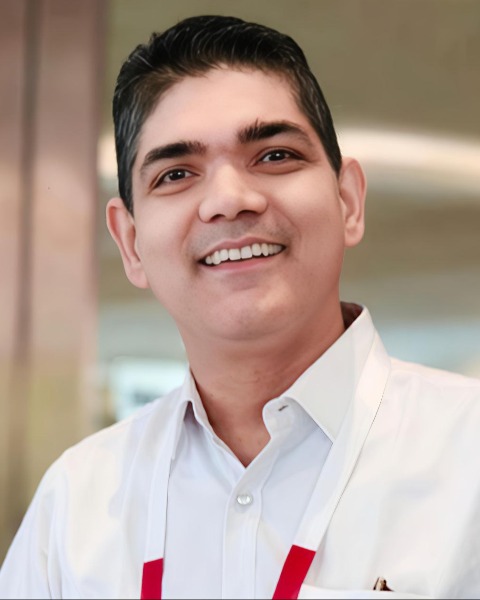Sunday Poster Session
Category: Biliary/Pancreas
P0098 - Clinical Outcome of Combined ERCP and Spy Glass-Laser Lithotripsy in Large Impacted CBD Stones: A Single-Center Experience
Sunday, October 26, 2025
3:30 PM - 7:00 PM PDT
Location: Exhibit Hall

Bhagwan Singh Thakur, MBBS, MD, DM
Choithram hospital and research centre
Indore, Madhya Pradesh, India
Presenting Author(s)
Shubham Upadhyay, MBBS, DNB1, Kunal Adhyaru, MBBS1, Amber Mittal, MBBS, MD, DrNB2, Mayank Jain, MBBS, MD, DrNB2, Bhagwan Singh Thakur, MBBS, MD, DM2
1National board of examination, Indore, Madhya Pradesh, India; 2Choithram hospital and research centre, Indore, Madhya Pradesh, India
Introduction: Direct endoscopic visualization of the biliopancreatic duct using the single-operator SpyGlass system has significantly improved the management of complex biliary disorders. When integrated with Holmium laser lithotripsy, this platform provides a valuable therapeutic tool, especially in cases involving impacted common bile duct (CBD) stones, distal biliary strictures, and cholangitis. These conditions often pose challenges for standard ERCP-based stone retrieval techniques.
Case Description/
Methods: We present a case series of four patients (2 females, 2 males; aged 22–81 years) with impacted CBD stones and associated distal CBD strictures and/or cholangitis. All patients had previously undergone ERCP with biliary stenting and presented with failure of stone clearance.
A standardized ERCP protocol was employed, including:
Following these steps, cholangioscopy was performed using the SpyGlass system for direct visualization of the ductal system, assessment of distal strictures, and guided laser lithotripsy using a Holmium laser to fragment the stones. Stone sizes ranged from 8×6 mm to 25×20 mm. Stent placements included either double pig-tail or metal biliary stents. Additional clinical findings included a large pyogenic liver abscess, post-laparoscopic cholecystectomy status, and cholelithiasis in select patients.
Discussion: SpyGlass-assisted cholangioscopy facilitated targeted stricture assessment and effective stone fragmentation using Holmium laser lithotripsy in all patients. The procedure was successful in achieving complete ductal clearance without post-procedure complications.
This series illustrates the potential clinical benefit of integrating ERCP with direct cholangioscopy and laser lithotripsy in the management of difficult CBD stones complicated by strictures or infection. While these preliminary outcomes are promising, larger studies are warranted to validate the efficacy, safety, and long-term outcomes of this combined approach.
Disclosures:
Shubham Upadhyay indicated no relevant financial relationships.
Kunal Adhyaru indicated no relevant financial relationships.
Amber Mittal indicated no relevant financial relationships.
Mayank Jain indicated no relevant financial relationships.
Bhagwan Singh Thakur indicated no relevant financial relationships.
Shubham Upadhyay, MBBS, DNB1, Kunal Adhyaru, MBBS1, Amber Mittal, MBBS, MD, DrNB2, Mayank Jain, MBBS, MD, DrNB2, Bhagwan Singh Thakur, MBBS, MD, DM2. P0098 - Clinical Outcome of Combined ERCP and Spy Glass-Laser Lithotripsy in Large Impacted CBD Stones: A Single-Center Experience, ACG 2025 Annual Scientific Meeting Abstracts. Phoenix, AZ: American College of Gastroenterology.
1National board of examination, Indore, Madhya Pradesh, India; 2Choithram hospital and research centre, Indore, Madhya Pradesh, India
Introduction: Direct endoscopic visualization of the biliopancreatic duct using the single-operator SpyGlass system has significantly improved the management of complex biliary disorders. When integrated with Holmium laser lithotripsy, this platform provides a valuable therapeutic tool, especially in cases involving impacted common bile duct (CBD) stones, distal biliary strictures, and cholangitis. These conditions often pose challenges for standard ERCP-based stone retrieval techniques.
Case Description/
Methods: We present a case series of four patients (2 females, 2 males; aged 22–81 years) with impacted CBD stones and associated distal CBD strictures and/or cholangitis. All patients had previously undergone ERCP with biliary stenting and presented with failure of stone clearance.
A standardized ERCP protocol was employed, including:
Removal of previously placed stents
Papillary balloon dilation (15 mm)
Biliary sweeping using an extractor balloon
Following these steps, cholangioscopy was performed using the SpyGlass system for direct visualization of the ductal system, assessment of distal strictures, and guided laser lithotripsy using a Holmium laser to fragment the stones. Stone sizes ranged from 8×6 mm to 25×20 mm. Stent placements included either double pig-tail or metal biliary stents. Additional clinical findings included a large pyogenic liver abscess, post-laparoscopic cholecystectomy status, and cholelithiasis in select patients.
Discussion: SpyGlass-assisted cholangioscopy facilitated targeted stricture assessment and effective stone fragmentation using Holmium laser lithotripsy in all patients. The procedure was successful in achieving complete ductal clearance without post-procedure complications.
This series illustrates the potential clinical benefit of integrating ERCP with direct cholangioscopy and laser lithotripsy in the management of difficult CBD stones complicated by strictures or infection. While these preliminary outcomes are promising, larger studies are warranted to validate the efficacy, safety, and long-term outcomes of this combined approach.
Disclosures:
Shubham Upadhyay indicated no relevant financial relationships.
Kunal Adhyaru indicated no relevant financial relationships.
Amber Mittal indicated no relevant financial relationships.
Mayank Jain indicated no relevant financial relationships.
Bhagwan Singh Thakur indicated no relevant financial relationships.
Shubham Upadhyay, MBBS, DNB1, Kunal Adhyaru, MBBS1, Amber Mittal, MBBS, MD, DrNB2, Mayank Jain, MBBS, MD, DrNB2, Bhagwan Singh Thakur, MBBS, MD, DM2. P0098 - Clinical Outcome of Combined ERCP and Spy Glass-Laser Lithotripsy in Large Impacted CBD Stones: A Single-Center Experience, ACG 2025 Annual Scientific Meeting Abstracts. Phoenix, AZ: American College of Gastroenterology.
